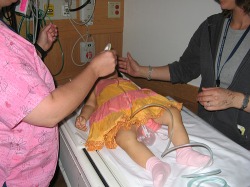DIAGNOSIS

Cerebral palsy is diagnosed by a complete examination of your child's current health status. Doctors will test your child's motor skills and look carefully at his or her medical history. They will also look for slow development, abnormal muscle tone, and unusual posture. When diagnosing cerebral palsy, doctors must rule out other disorders that can cause abnormal movements. Cerebral palsy does not get worse. In other words, it is not progressive. Based on this fact, doctors must make the determination that your child's condition is not progressively getting worse. Doctors will also use a number of different specialized tests in diagnosing cerebral palsy. For example, the doctor may order a CT (computed tomography). This is an imaging of the brain that can determine underdeveloped areas of brain tissue. The doctor may also order an MRI (magnetic resonance imaging). This test also generates a picture of the brain to determine areas that may be damaged. In addition to these imaging tests, intelligence testing is also used. This helps to determine if a child is behind from a mental standpoint. In addition to diagnosing cerebral palsy through a complete and thorough examination of the child's abnormalities and behaviors, a review of the mother's pregnancy, labor and delivery and care received is also conducted.
| diagnosis.wma |
Source:
Zisook, S. O. (12, 10 08). What is Cerebral Palsy? Retrieved June 22, 2001, from Cerebral Palsy—Ask the Doctor: http://www.about-cerebral-palsy.org/definition/index.html
